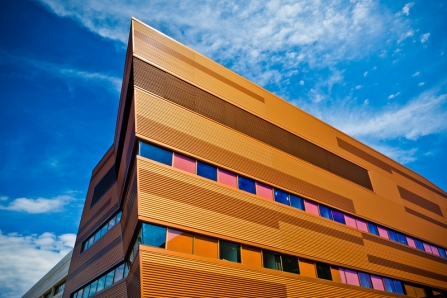The new home of the School of Engineering and Applied Sciences, designed by Perkins+Will, opened at the University at Buffalo. Co-locating the departments of computer science and electrical engineering in a single facility, the 133,000-sf Barbara and Jack Davis Hall creates an collaborative education and research environment.
Clad in glass and copper-colored panels, the three-story building thrusts outward from the core of the campus to establish a new identity for the School of Engineering and Applied Sciences and the campus at large. Formerly scattered among seven different locations, the engineering campus is now focused and consolidated, with a defined “front door” for the school and a new quad and interior common spaces.??
Davis Hall will enable the University at Buffalo to expand research in nanotechnology, pattern recognition and bio-based security systems, among other fields. The hybrid design of the hall stresses the value of interactive space for learning and discovery. The building is organized around a glass-enclosed, multi-story gallery that facilitates pedestrian traffic into the existing campus, creates an interactive educational/research environment, and culminates in a multi-tiered student lounge that activates a new courtyard shared with the existing Marcel Breuer buildings.
Facing south, the glass gallery is a daylight-filled science commons that includes open staircases that allow for spontaneous student and staff interaction. It also comprises a series of interlocking volumes that include windows into laboratories for the active display of technological research. Throughout the building, which also houses the Center of Excellence in Document Analysis and Recognition (CEDAR) and the Center for Unified Biometrics and Sensors (CUBS), cross-disciplinary zones are distributed for informal gathering spaces equipped with SMART Boards.
The new hall is tracking for USGBC LEED Gold certification through features like enhanced building shell insulation, high-performance windows and energy efficient lighting, the building improves overall energy performance 33.8% above the baseline ASHRAE 90.1-2004 requirements. +
Related Stories
| Sep 22, 2010
Michael Van Valkenburg Assoc. wins St. Louis Gateway Arch design competition
Landscape architect Michael Van Valkenburgh and a multidisciplinary team of experts in “urban renewal, preservation, commemoration, social connections and ecological restoration” have been picked for the planning phase of The City+The Arch+The River 2015 International Design Competition.
| Sep 22, 2010
Satellier, Potential + Semac close investment deal
Satellier, a world leader in providing CAD and Building Information Modeling (BIM) outsourced services to the architecture, engineering and construction industry, announces a strategic minority investment from India-based top engineering firm Potential + Semac, ushering in the next evolution of the global architecture support industry.
| Sep 21, 2010
New BOMA-Kingsley Report Shows Compression in Utilities and Total Operating Expenses
A new report from the Building Owners and Managers Association (BOMA) International and Kingsley Associates shows that property professionals are trimming building operating expenses to stay competitive in today’s challenging marketplace. The report, which analyzes data from BOMA International’s 2010 Experience Exchange Report® (EER), revealed a $0.09 (1.1 percent) decrease in total operating expenses for U.S. private-sector buildings during 2009.
| Sep 21, 2010
Forecast: Existing buildings to earn 50% of green building certifications
A new report from Pike Research forecasts that by 2020, nearly half the green building certifications will be for existing buildings—accounting for 25 billion sf. The study, “Green Building Certification Programs,” analyzed current market and regulatory conditions related to green building certification programs, and found that green building remain robust during the recession and that certifications for existing buildings are an increasing area of focus.
| Sep 21, 2010
Middough Inc. Celebrates its 60th Anniversary
Middough Inc., a top ranking U.S. architectural, engineering and management services company, announces the celebration of its 60th anniversary, says President and CEO, Ronald R. Ledin, PE.








